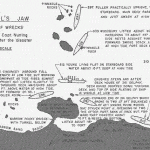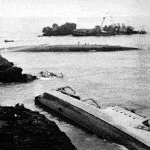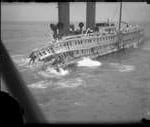The Wrecks and Disaster of Honda Point and the “Devils Jaw”
The Destroyers of Honda
Diving the Destroyers at Honda
Other wrecks in the Honda area
 The Honda Point disaster happened on 8 September 1923 when the US Navy lost one and a half destroyer divisions, seven ships in a mass wreck grounding that lasted less than 5 minutes at Honda Point, California. Honda Point is a treacherous area (jagged rock pinnacles and reefs) just a little North of Point Arguello, off of Vandenberg Air Force base, also known as the “Devil’s Jaw”. This is the Danger zone 4 area of the Pacific Missile test range also known as the “Graveyard of the Pacific.” This peacetime disaster had few equals at the time, and still remains one of the worst such wrecks disasters in US Navy history.
The Honda Point disaster happened on 8 September 1923 when the US Navy lost one and a half destroyer divisions, seven ships in a mass wreck grounding that lasted less than 5 minutes at Honda Point, California. Honda Point is a treacherous area (jagged rock pinnacles and reefs) just a little North of Point Arguello, off of Vandenberg Air Force base, also known as the “Devil’s Jaw”. This is the Danger zone 4 area of the Pacific Missile test range also known as the “Graveyard of the Pacific.” This peacetime disaster had few equals at the time, and still remains one of the worst such wrecks disasters in US Navy history.
On the night of 8 September, the ships of Destroyer Squadron (DesRon) 11 were on a 24 hour run from San Francisco to San Diego, cruising at 20 knots. The flagship, USS Delphy (DO 261) was in the lead, followed by Destroyer Divisions 33, 31, and 32; ships as follows:
DesDiv 33: S. P. Lee (DD 310), Young (DD 312), Woodbury (DD 309), Nicholas (DD 311)
DesDiv 31: Farragut (DD 300), Fuller (DD 297), Percival (DD 298), Somers (DD 301), Chauncey (DO 296)
DesDiv 32: Kennedy (DO 306), Paul Hamilton (DO 307), Stoddert (DO 302), Thompson (DO 305)
 A navigational error and unusual currents caused by the Tokyo earthquake of the previous week along with a decision to maintain a speed of 20 knots and not stop and take soundings, caused the lead destroyer to change heading after believing that they were south of Pt. Conception The ships turned east, supposedly into the Santa Barbara Channel, at 2100 hours. In reality, the ships were headed for the rocky shore.
A navigational error and unusual currents caused by the Tokyo earthquake of the previous week along with a decision to maintain a speed of 20 knots and not stop and take soundings, caused the lead destroyer to change heading after believing that they were south of Pt. Conception The ships turned east, supposedly into the Santa Barbara Channel, at 2100 hours. In reality, the ships were headed for the rocky shore.
The ships soon entered a thick fog bank, each vessel following the wake of the ship ahead. 5 minutes after the turn, Delphy ran ashore, quickly followed by other members of the squadron. S. P. Lee went ashore broadside to the shoreline cliffs to the north of Delphy. Nicholas stuck on a reef to seaward of S. P. Lee. Young came ashore aft of Delphy and was quickly rolled onto her side by the flagship’s propeller wash. Woodbury wrecked on a group of rocks offshore, and Fuller was wrecked on the rocks just beyond Woodbury.
Lastly, Chauncey grounded inshore of the capsized Young. Somers and Farragut were warned by Delphy’s siren and they slowed considerably before coming ashore; both were able to back off without major damage. The other ships of the squadron avoided grounding completely. The ships came to rest in two groups: the main group with Fuller, Woodbury, Young, Chauncey, and Delphy roughly in a line, and S. P. Lee & Nicholas together to the north of the other ships. In the aftermath of the grounding, the Delphy capsized and Nicholas’ bow broke off. The destroyers that went aground were known as Greyhounds for their speed and were 314 feet long and 32 feet wide
 Rescue efforts began immediately. The survivors from Young escaped to Chauncey via a lifeline. Fishing boats summoned by the surviving ships worked among the rocks, plucking the crews off Fuller and Woodbury. Local ranchers, awakened by Delphy’s siren, hastened to set up breeches buoys from the top of the cliffs down to the wrecked ships. Other survivors waded ashore through the rocks. 23 men were lost, mostly from the capsized Young. The survivors were taken to San Diego by a special train shortly after being rescued.
Rescue efforts began immediately. The survivors from Young escaped to Chauncey via a lifeline. Fishing boats summoned by the surviving ships worked among the rocks, plucking the crews off Fuller and Woodbury. Local ranchers, awakened by Delphy’s siren, hastened to set up breeches buoys from the top of the cliffs down to the wrecked ships. Other survivors waded ashore through the rocks. 23 men were lost, mostly from the capsized Young. The survivors were taken to San Diego by a special train shortly after being rescued.
The ships were total losses. They were stricken from the Register, stripped of usable equipment, and sold to a scrapper for $1,035. No salvage work was done, and the ships remain where they were wrecked. Chauncey’s remains are still visible. The area is now of Vandenberg AFB.
The destroyers of Honda
USS Delphy (DO 261)-The Delphy was built on July 18, 1918, at the Bethlehem Shipbuilding Corp., Squantum, Massand. She was a steel-hulled ship, 314’ in length, 31.8” wide, and 1,190 tons.
S. P. Lee (DD 310)- The S.P. Lee was built on December 31, 1918, Bethlehem Shipbuilding Corp., San Francisco, Calif., She was a steel-hulled ship, 314’ in length, 30’ wide, and 1,308 tons
Young (DD 312) -The Young was built on January 28 1919 in San Francisco, Calif., by the Union Iron Works Plant of the Bethlehem Shipbuilding Corp. She was a steel-hulled ship, 314’ in length, 31’ wide, and 1,190 tons
Woodbury (DD 309)-The Woodbury was built on October 3, 1918, in San Francisco, Calif., by the Union Iron Works plant of the Bethlehem Shipbuilding Corp. She was a steel-hulled ship, 314’ in length, 30’ wide, and 1,308 tons.
Nicholas (DD 311) -The Nicholas was built on January 11, 1918, Bethlehem Shipbuilding Corp., San Francisco, Calif., She was a steel-hulled ship, 314’ in length, 30’ wide, and 1,190 tons
Fuller (DD 297)–The Fuller was built on December 5, 1918, at the Bethlehem Shipbuilding Corp., San Francisco Calif. She was a steel-hulled ship, 314’ in length, 31’ wide, and 1,215 tons.
Chauncey (DO 296)-The Chauncey was built on September 29, 1918, at the Union Iron Works, San Francisco, Calif. She was a steel-hulled ship, 314’ in length, 31’ wide, and 1,215 tons.
Diving the destroyers at Honda
Underwater, Honda is a wreck diver’s dream. Wreckage is everywhere. Perpetually buffeted by sand and surge, pieces of brass gleam like gold. Many of the more delicate pieces of fittings and machinery have been crushed, bent, or twisted by larger debris and rocks. Not looking like classic wrecks anymore, the metal has been pounded from the proud form of a destroyer into a pulverized metal reef. Surprisingly, some artifacts have survived in remarkably good condition, but shipwreck legislation prevents any wreckage from being taken.
Why is it so special? The wrecks here are some of the least dived in California. This area is known for its remoteness and rough weather, also it’s a 5-8 hour ride from Santa Barbara or Ventura. To enter this area you must have permission from Vandenberg Air Force base and even if you get the permission the weather may not cooperate.
How the diving is and what will I see? The diving here is very interesting. There is no penetration of the wrecks, although there is plenty of sharp twisted jagged metal all over, so you must use plenty of caution. There is a lot of wreckage and brass parts to see and some of the biggest fish you will ever find. There is always a surge present due to the shallow depths (10’-50′) and the visibility is normally between 10’-30′. The best time to dive at Honda is late summer early fall.
What wrecks are there? The area from Point Conception to Destroyer Rock has claimed 14 wrecks:
- The 314′ U.S. Destroyers known as the “Greyhounds” because of their 34-knot cruising speeds. They ran aground on September 8, 1923
- The Harvard, a 400′ passenger liner that sunk on May 30, 1931
- The Yankee Blade, a 274′ steam Side-wheeler that sunk on October 1, 1854.
- The Nippon Maru, a Japanese oil Tanker that sunk on May 28, 1933.
Warning-To wreck divers, Honda is a sort of Holy Grail, and reaching Honda is NEVER guaranteed. The weather could become uncooperative especially once you pass Point Conception, but then that is part of the adventure and those who have been to Honda are fully aware of. Just the chance to get there and dive the wrecks is something that doesn’t happen often.
Other wrecks in the Honda area
 The SS Harvard was built by the Delaware River Shipbuilding Company and launched at the end of January 1907. She was steam turbine-powered with 3 turbines and capable of traveling at over 24 knots. The Harvard was 403′ long and 51′ wide and could carry up to 500 passengers. She first served on the east coast and then sold and moved to the west coast.
The SS Harvard was built by the Delaware River Shipbuilding Company and launched at the end of January 1907. She was steam turbine-powered with 3 turbines and capable of traveling at over 24 knots. The Harvard was 403′ long and 51′ wide and could carry up to 500 passengers. She first served on the east coast and then sold and moved to the west coast.
Later she was taken over by the U.S. Navy for World War 1. In later 1920 when the U.S. Navy was done with her she was sold, refitted, and started back to her old route on the west coast. While on her route very early in the morning on May 30, 1931, she ran aground and was wrecked 4 nm North of Point Arguello never to cruise the ocean again.
Diving the Harvard is an incredible experience and one that not many people get a chance to do. She is all broken up now and for the most part, fused into the rock and sand, but there is still much to see in the shallow area where she now rests. There is also some of the biggest fish you will see, but then that is due to this area being seldom visited.
The Yankee Blade was a 3 masted Side wheel steamer built in New York in 1853. She was 274’ in length, 37’ in width, and 1,767 tons. The Yankee Blade served a short time on the East coast until being sold and moved to the Pacific coast for the San Francisco to Panama route. On September 30 she struck a rock (known as Blade Rock) off Honda and on October 1, 1854, she sunk. There are still some pieces of the engines and machinery at the base of the rock at about 65’-70’ deep. Visibility here is generally not the best at 5’-15’. The Yankee Blade is on the National Register of Historic Places.
The Nippon Maru was a 400′ x 52′ Japanese oil Tanker that was launched in 1919 and built for the Imperial Japanese Navy. There is not much known about the Nippon Maru except that she became grounded along the shores of Honda from a very big navigational error on a very foggy evening on May 28, 1933. She was re-floated and salvaged on the spot for several months until she finally slipped back into the sea where she now rests with the destroyer fleet.
Diving the Nippon Maru is exciting, but you are not really sure which wreck you are diving as she sits twisted into and on the remains of the destroyers. It is more like a toppled erector set underwater with stuff to see everywhere when the weather cooperates. Either way, it is an exciting adventure.
For more information on all the wrecks please see the California Wreck Divers website and another very excellent source is the out-of-print book “Shipwrecks of Southern California” by Bonnie J. Cardone and Patrick Smith.